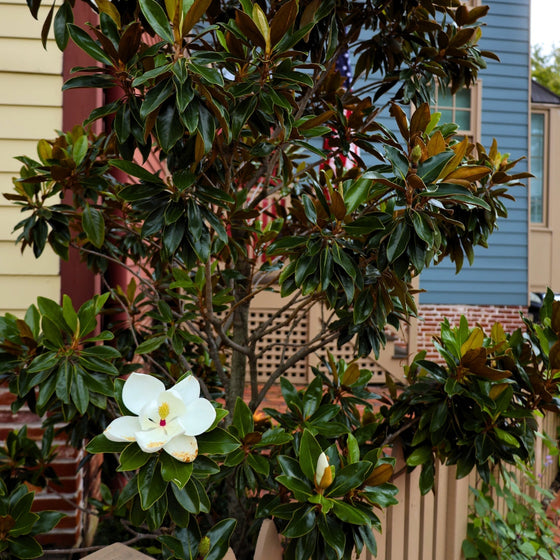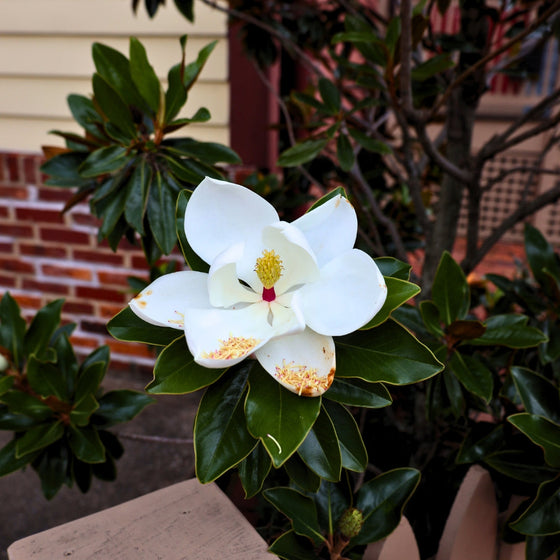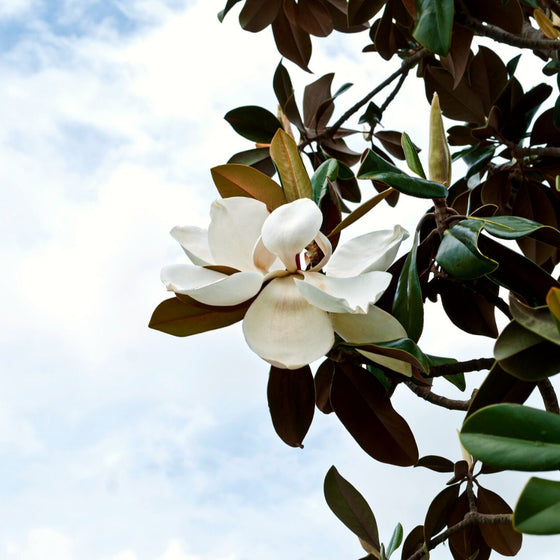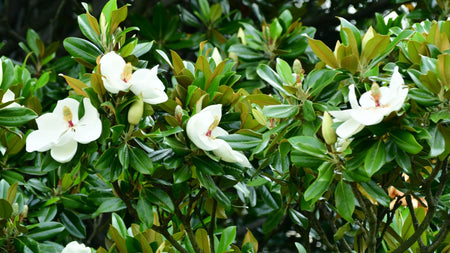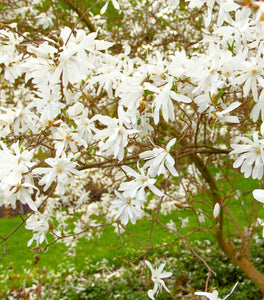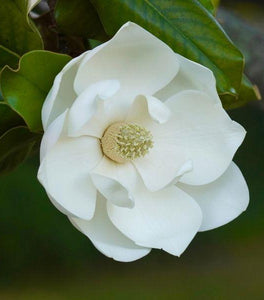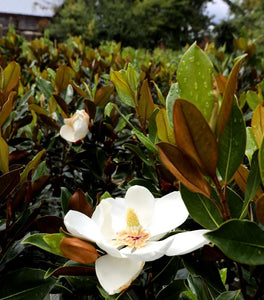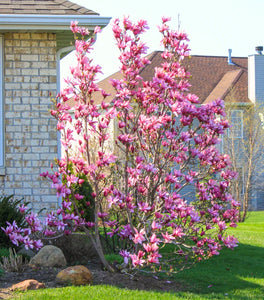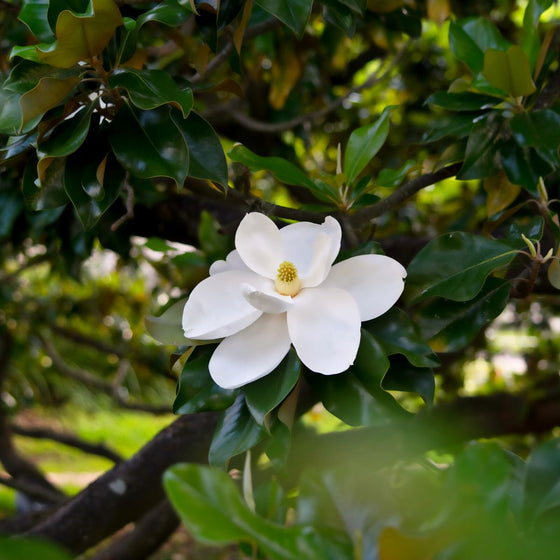
Images Depict Mature Plants
DD Blanchard Magnolia Trees
Magnolia ‘D.D. Blanchard’ is a stunning evergreen Southern Magnolia cultivar known for its glossy, dark green leaves with rich, copper-toned undersides and impressive floral display. This classic magnolia variety produces large, fragrant white flowers—up to 10 inches across—from late spring through summer, creating a dramatic focal point in any landscape. Its stately, pyramidal shape and year-round foliage make it a favorite for use as a specimen tree, privacy screen, or ornamental anchor in southern and transitional gardens.
Reaching heights of 40 to 50 feet with a spread of 20 to 30 feet, D.D. Blanchard Magnolia offers both shade and elegance, making it ideal for larger properties, estate-style plantings, or long-term landscape planning. It thrives in full sun to partial shade and prefers moist, well-drained, slightly acidic soil. Once established, this magnolia is drought tolerant and moderately salt-tolerant, making it suitable for coastal regions as well as inland landscapes. Its leathery leaves and strong branch structure give it excellent wind resistance, contributing to its lasting performance in various conditions.
In addition to its ornamental value, Magnolia D.D. Blanchard provides food and shelter for pollinators and birds, supporting a more biodiverse landscape. Its tolerance for urban environments and low-maintenance nature make it a practical yet elegant choice for residential or commercial properties. Whether you're designing a formal garden, a southern-inspired landscape, or seeking an evergreen with year-round impact, D.D. Blanchard Magnolia brings timeless beauty, fragrant blooms, and architectural presence to any outdoor space.

| Hardiness Zone: | 6-10 |
|---|---|
| Mature Height: | 35 to 50 Feet |
| Mature Width: | 20 to 30 Feet |
| Classification: | Broad leaved evergreen tree, spring flowering |
| Sunlight: | Full sun |
| Habit: | Upright, pyramidal to oval |
| Foliage: | Dark green topside with cinnamon colored underside |
| Flower Color: | White, fragrant flowers in late spring |
| Pruning Season: | No pruning needed |
| Soil Condition: | Any well drained soil |
| Water Requirements: | Water well until established |
| Uses: | Tolerates moist soil and full sun. Full sun brings out the best fall color. Will adapt to drier sites |
How to Care for Magnolia DD Blanchard
Before you buy a Magnolia ‘D.D. Blanchard’, make sure to read about the care instructions that are recommended to keep this plant healthy and thriving.
How Do I Plant My Magnolia D.D. Blanchard?
To plant your Magnolia D.D. Blanchard, choose a location with full sun to partial shade and well-drained, slightly acidic soil. This evergreen magnolia prefers ample space to grow, as it can reach heights of 40 to 50 feet with a spread of 20 to 30 feet. Dig a hole twice as wide and just as deep as the root ball, and gently loosen the roots before placing the tree in the hole. Position the tree so that the top of the root ball is level with the surrounding soil, backfill with native soil, and water thoroughly to eliminate air pockets and help establish the roots. After planting, apply a 2–3 inch layer of mulch around the base of the tree to conserve moisture, regulate soil temperature, and suppress weeds—keeping the mulch a few inches away from the trunk to prevent rot. Water regularly during the first year, especially in dry periods, to support deep root development. Magnolia D.D. Blanchard makes an excellent specimen tree or privacy screen and thrives in large landscapes where its full size and beauty can be appreciated. With proper planting and early care, this stately magnolia will provide decades of fragrant blooms, rich evergreen foliage, and timeless elegance.
How Do I Water My Magnolia D.D. Blanchard?
Watering your Magnolia D.D. Blanchard properly is essential for establishing a healthy, deep-rooted tree. During the first year after planting, water deeply once or twice per week, depending on weather and soil conditions, to keep the root zone consistently moist but not soggy. Focus on slow, deep watering to encourage the roots to grow downward rather than staying near the surface. Using a soaker hose or drip irrigation system can be especially effective for evenly saturating the soil. Always check the top few inches of soil before watering—if it feels dry, it’s time to water. Once established, D.D. Blanchard Magnolia becomes moderately drought tolerant but will benefit from supplemental watering during prolonged dry spells, particularly in the summer. A 2–3 inch layer of organic mulch around the base helps conserve soil moisture and reduce watering frequency while also improving overall soil health. Avoid overhead watering, which can lead to fungal issues on the glossy evergreen leaves. With the right watering routine, your Magnolia D.D. Blanchard will maintain its rich foliage and continue producing large, fragrant white blooms that enhance your landscape year after year.
How Do I fertilize My Magnolia D.D. Blanchard?
Fertilizing your Magnolia D.D. Blanchard helps promote healthy growth, lush evergreen foliage, and abundant flowering. Apply a balanced slow-release fertilizer, such as a 10-10-10 or a formula specifically designed for acid-loving trees, in early spring just as new growth begins. Spread the fertilizer evenly around the drip line of the tree—avoiding direct contact with the trunk—and water it in thoroughly to help the nutrients absorb into the soil. For newly planted trees, use a lighter application to avoid stressing young roots, and consider incorporating organic compost to naturally enrich the soil. Mature D.D. Blanchard Magnolia trees typically benefit from annual feeding in early spring, but if the tree is growing in nutrient-rich soil, you may only need to fertilize every other year. Avoid high-nitrogen fertilizers, which can encourage excessive leaf growth at the expense of flowers. A soil test can help you determine specific nutrient deficiencies if the tree shows signs of yellowing leaves or reduced blooming. With a consistent fertilizing schedule tailored to its needs, your Magnolia D.D. Blanchard will thrive as a stunning landscape centerpiece, offering year-round evergreen beauty and seasonal, fragrant white blossoms.

How and When Should I Prune My Magnolia D.D. Blanchard?
Pruning your Magnolia D.D. Blanchard should be done sparingly and at the right time to maintain its natural shape and health. The best time to prune is in late winter to early spring, just before new growth begins, or immediately after the tree finishes blooming in early summer. Begin by removing any dead, damaged, or diseased branches, as well as any crossing or rubbing limbs that can affect airflow and structure. Avoid heavy pruning, as magnolias do not respond well to severe cuts, and over-pruning can stress the tree and reduce flowering. For shaping and size control, focus on light, selective pruning to enhance the tree’s natural pyramidal form. Use clean, sharp tools to make smooth cuts just outside the branch collar, and avoid topping or shearing, which can lead to weak, unattractive growth. Regularly removing lower limbs can also help raise the canopy if desired for clearance or visual effect. With thoughtful, minimal pruning, your Magnolia D.D. Blanchard will maintain its stately appearance, produce its signature fragrant white flowers each year, and serve as a long-lasting evergreen focal point in your landscape.

